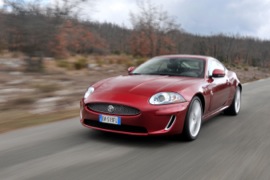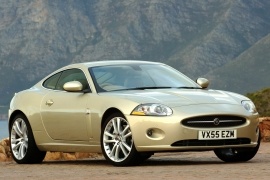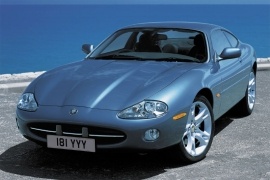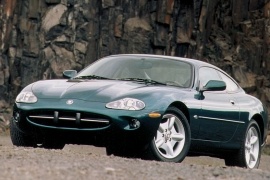JAGUAR XK Models/Series Timeline, Specifications & Photos
First production year: 1996
Engines: Gasoline
Body style: Coupé (two-door)
The refined and powerful Jaguar XK coupe was a nice blend of performance, comfort and luxury. Revised for 2011, the XK featured several updates.
Both front and rear exterior styling changes were made and the interior was updated with a navigation system and a back-up camera as standard.
At the front, the updated XK featured slimmer headlamps fitted with LED running lights, a refreshed larger grille and small air scoops on the grille’s sides. The redesigned taillights were fitted with LED technology.
Well loaded in its base (XK) level, the Jaguar XK was equipped with 19-inch alloys, bi-xenon headlights, parking sensors (front and rear), keyless ignition, keyless entry, leather upholstery, heated and cooled front seats, automatic dual-zone climate control, a touchscreen display, Bluetooth connectivity, a premium Bower & Wilking sound system and a heated steering wheel.
Many stand-alone options were available, such as interior piano black wood, a heated windshield, adaptive cruise control, active headlights, a supercharged engine, bigger 19-inch alloys, more effective brakes, unique interior trims, different body colors. The XKR trim level added optional red brake callipers and included all the optional features available for the XK.
The interior offered upper-class comfort with a well-tailored cockpit and high-quality materials used throughout.
Safety wise, the standard equipment included ABS with brake assist, stability control, traction control and front-seat side airbags.
Ian Callum was one of the best designers that ever shaped the Jaguar vehicles' lines, and the XK was a great example of what he did for the British brand.
While Ford was still owning the Jaguar, they understood that the two-decades-old Jaguar XJS had to be replaced. Ian Callum was assigned to design the new cat, which had to be a GT fast enough to compete against the finest European coupes from those times.
Callum took its inspiration from one of the most beautiful cars in the world, the E-Type. Enzo Ferrari himself made that statement about the E-Type, so blame him if I'm wrong. The oval-shaped grille of the XK resembled the glorious '60s model from Jaguar. Its odd-looking headlights were unique on the market, and the deep holes for the fog-lights looked like they were designed for the machine-guns in a James Bond car. The all-aluminum unibody construction was continued by a very raked windshield and a short roof before the sloped, aerodynamic rear end.
Inside, the British luxury could have been at its best. Apart from some Ford Fiesta buttons and switches, everything else was luxurious. The expensive Connely leather and the wood trims completed an atmosphere of exclusivity and good taste. It was the first Jaguar that didn't feature the traditional J pattern for the gear selector. It was more of a reversed L.
Apart from the ferocious XKR, the rest of the range was fitted with a choice of three V8 engines. All of them were paired to a 6-speed automatic gearbox and sent the power to the rear wheels.
Six years after the model’s introduction, Jaguar launched the refreshed version of the XK8, and besides some styling updates, it also improved the engine performance.
While it was difficult to improve the XK8’s design, there were still some parts that the automaker could work on. Furthermore, Ford tried to lower production costs, so the facelifted version featured some bits and pieces carried over from the blue-oval brand, which owned Jaguar. But that wasn’t all. The automaker upgraded the V8 under the hood to deliver more power and torque, keeping the British grand tourer in shape to face its competitors. But still, even if it was capable of some performance, it was not a sports car.
Ian Callum penned the lines of the original XK8, and it was difficult for Ford to improve what the British designer made. But there were some parts of the car that could be modernized. At the front, the grand tourer featured a new design for the oval-shaped grille. A chromed trim still crossed it, but there were two additional vertical body-colored slats in the middle. Furthermore, the automaker installed new, clear-lenses headlights, which made the car look young again, despite being launched in 1996.
From its profile, the XK8 was a beauty with its long hood and low-slung greenhouse. All these advantages were kept by the 2002 model year, but there were new options for wheels and body colors. At the back, the automaker made subtle upgrades to the car. It installed new taillights with a cleaner look and integrated a small lip spoiler into the trunk’s lid. Furthermore, on the lower side, a newly designed bumper featured side-mounted parking lights, while the fog lamp was deleted since it was integrated into the taillights.
The luxurious interior of the 2002 XK8 showed some slight updates compared to the non-facelifted version. At the front, gone were the seats with integrated headrests. The 2002 model year came with adjustable ones, which divided customers. But still, the new seats provided better side support, even though they were not high bolstered. The recessed dials from the instrument cluster featured silver encirclements, emphasizing the classic styling but in a beautiful way. But still, even though there was a bench seat in the back, legroom and headroom were a pain for adults carried on long journeys.
Under its skin, the 2002 XK8 featured a revised platform. The car featured improved shock absorbers and new springs that improved the car’s speed cornering. Since Jaguar chased the SL from Mercedes-Benz, it had to keep up with the German GT, and it did. Both could support similar lateral acceleration. Regarding powerplant, the newly developed 4.2-liter V8 could send 300 hp (305 PS) to the rear via a six-speed automatic that replaced the previously used five-speed one. As a result, the car was slightly faster than its predecessor, but it retained the same capped speed of 155 mph (250 kph).
Jaguar introduced the XK8 in 1996 at the Geneva Motor Show, and the beautiful British coupe stole the show with its elegant lines and, most importantly, what it had under its hood.
Jaguar considered replacing the aging XJS model that was introduced by the British automaker more than two decades before, in 1975. It even developed a platform and an engine for the replacement model back in the ‘80s. But then, in November 1989, Ford bought Aston Martin and Jaguar and postponed the car’s launch. The new owner considered that the already developed car should appear on the more expensive Aston Martin, and only afterward was Jaguar allowed to release its big coupe grand tourer. As a result, its sporty sibling company, Aston Martin, launched the DB7 in September 1994. After a year and a half, in March 1996, Jaguar pulled the wraps off the XK8.
The new model appeared during the bio-design era, and the XK8’s front fascia followed those lines. It featured an oval-shaped grille crossed by a chromed horizontal slat. The badge was above it, while on the lower side of the bumper, the automaker added a discreet spoiler. Jaguar installed new, swept-back headlights and placed the fog lamps below them. The longitudinal power dome on the hood confused clients, who thought that the car featured an inline powerplant, albeit it was a V8 in the engine bay.
From its profile, the elegant lines penned by Ian Callum offered a timeless design to the vehicle. Thanks to the long hood and the short rear deck, the XK8 resembled the legendary E-Type from the ‘60s. The raked windshield opened the way for the low-slung greenhouse. At the back, the automaker installed a sloped window followed by the trunk lid. On the rear fascia, the designer installed rounded taillights that flanked the trunk opening, while underneath the bumper, the automaker placed a pair of chromed exhausts on the sides.
The leather-wrapped interior boasted a high level of elegance and luxury. Jaguar placed walnut trims on the dashboard, the center console, and on the door cars. The recessed dials fronted the driver, while the center stack housed the HVAC controls and the stereo. Jaguar offered the XK8 with a cassette player and, as an option, a nine-speaker sound system with a CD changer in the trunk. A pair of comfortable bucket seats with available lumbar support for the driver was at the front, while in the back, there was hardly any room left for two passengers.
The XK8 came fitted with a 4.0-liter all-aluminum, twin-cam V8 engine under the hood. It was a first for a Jaguar, and the automaker paired it with a five-speed automatic transmission only. Power went to the rear wheels, and the independent suspension in all corners helped the car stay planted on the road while offering a comfortable ride as well.



